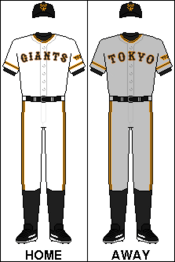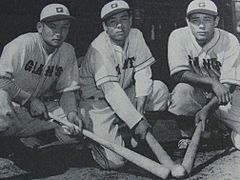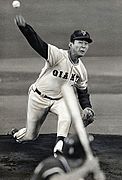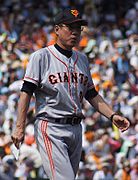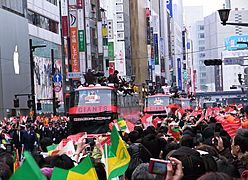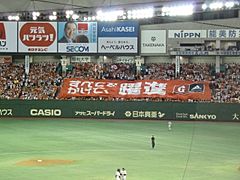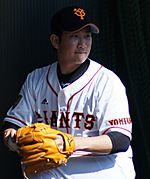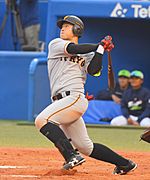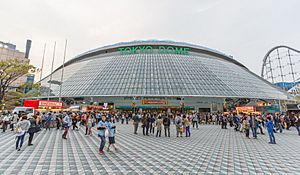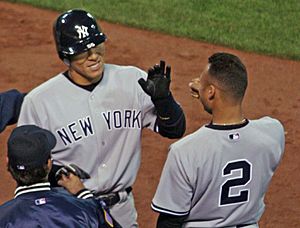Yomiuri Giants facts for kids
Quick facts for kids Yomiuri Giants |
|||||
|---|---|---|---|---|---|
|
|||||
| Information | |||||
| League | Nippon Professional Baseball
Japanese Baseball League (1936–1949) Independent (1934–1935) |
||||
| Location | Bunkyō, Tokyo, Japan | ||||
| Ballpark | Tokyo Dome | ||||
| Year founded | December 26, 1934 | ||||
| Nickname(s) | Kyojin (巨人, giant) | ||||
| CL pennants | 39 (1951, 1952, 1953, 1955, 1956, 1957, 1958, 1959, 1961, 1963, 1965, 1966, 1967, 1968, 1969, 1970, 1971, 1972, 1973, 1976, 1977, 1981, 1983, 1987, 1989, 1990, 1994, 1996, 2000, 2002, 2007, 2008, 2009, 2012, 2013, 2014, 2019, 2020, 2024) | ||||
| Japan Series championships | 22 (1951, 1952, 1953, 1955, 1961, 1963, 1965, 1966, 1967, 1968, 1969, 1970, 1971, 1972, 1973, 1981, 1989, 1994, 2000, 2002, 2009, 2012) | ||||
| JBL championships | 9 (1936 Fall, 1937 Spring, 1938 Fall, 1939, 1940, 1941, 1942, 1943, 1949) | ||||
| Former name(s) |
|
||||
| Former ballparks |
|
||||
| Colors | Orange, Black, White |
||||
| Mascot | Giabbit | ||||
| Playoff berths | 14 (2007, 2008, 2009, 2010, 2011, 2012, 2013, 2014, 2015, 2016, 2018, 2019, 2021, 2024) | ||||
| Retired numbers | |||||
| Ownership | Legally as KK Yomiuri Kyojingun (株式会社読売巨人軍) 100% owned by The Yomiuri Shimbun Holdings | ||||
| Management | Toshikazu Yamaguchi | ||||
| Manager | Shinnosuke Abe | ||||
| Uniforms | |||||
|
|
|||||
The Yomiuri Giants (読売ジャイアンツ, Yomiuri Jaiantsu, formally Yomiuri Kyojingun (読売巨人軍)) are a Japanese professional baseball team competing in Nippon Professional Baseball's Central League. Based in Bunkyo, Tokyo, they are one of two professional baseball teams based in Tokyo, the other being the Tokyo Yakult Swallows. They have played their home games in the Tokyo Dome since its opening in 1988. The team's owner is Yomiuri Shimbun Holdings, Japan's largest media conglomerate which also owns two newspapers (including the eponymous Yomiuri Shimbun) and the Nippon Television Network (which includes flagship Nippon TV).
The Giants are the oldest professional sports team in Japan. They are also by far the most successful, having won 22 Japan Series titles and an additional nine in the era of NPB's forerunner, the Japanese Baseball League. Their main rivalry is with the Hanshin Tigers, a team especially popular in the Kansai region. The Yomiuri Giants are regarded as "The New York Yankees of Japan" due to their widespread popularity, past dominance of the league, and polarizing effect on fans. (Baseball fans who are indifferent about teams other than their local team often have an intense dislike for the Giants; on the other hand, the Giants have a large fan base even in cities that have a team of their own.)
The English-language press occasionally calls the team the Tokyo Giants, but that name has not been in use in Japan for decades. (Lefty O'Doul, a former Major League Baseball player, named the team "Tokyo Giants" in the mid-1930s.) Instead, the team is officially known by the name of its corporate owner, just like the Hanshin Tigers and Orix Buffaloes. The team is often referred by fans and in news headlines and tables simply as Kyojin (巨人, the Japanese word for "giant(s)"), instead of the usual corporate owner's name or the English nickname.
The Yomiuri Giants name and uniforms were based on the New York (now San Francisco) Giants. The team's colors (orange and black) are the same colors worn by the National League's Giants (both then as now in both New York and San Francisco). The stylized lettering on the team's jerseys and caps is similar to the fancy lettering used by the Giants when they played in New York in the 1930s, although during the 1970s the Yomiuri Giants modernized their lettering to follow the style worn by the San Francisco Giants.
Contents
Franchise history
Great Japan Tokyo Baseball Club
The team began in 1934 as The Great Japan Tokyo Baseball Club (大日本東京野球倶楽部, Dai-Nippon Tōkyō Yakyū Kurabu), a team of all-stars organized by media mogul Matsutarō Shōriki that toured the United States and matched up against an American all-star team that included Babe Ruth, Jimmie Foxx, Lou Gehrig, and Charlie Gehringer. While prior Japanese all-star contingents had disbanded, Shōriki went pro with this group, playing in an independent league.
In 1935, the team traveled to the United States and faced off against college and minor league teams, ultimately playing 109 games in 128 days (including 34 games on 17 days as doubleheaders) across the country. The tour ended with a record of 75 wins, 33 losses, and 1 draw.
When they faced off against the San Francisco Seals, the manager of the Seals, Lefty O'Doul, stated the team needed a promotional name . He suggested that since Tokyo was the New York of Japan, they should emulate one of the two named MLB teams in New York; either the Yankees or the Giants (New York's third team, which would eventually be called the Dodgers, lacked an official nickname at the time). As "Yankees" was immediately out of the question, due to it being an American name, O'Doul suggested the name "Giants", and the team adopted the Tokyo Giants moniker mid-tour.
Tokyo Kyojin
In 1936, with the formation of the Japanese Baseball League, the team changed its name to the Tokyo Kyojin, often called the Tokyo Giants in non-Japanese sources. It won eight league championships under that name from 1936 to 1943, including six championships in a row from 1938 to 1943.
Russian-born pitcher Victor Starffin, nicknamed "the blue-eyed Japanese", starred for the team until 1944. One of the league's premier pitchers, he won two MVP awards and a Best Nine award, and won at least 26 games in six different years, winning a league-record 42 games in 1939. He followed his record-setting performance with another 38 wins in 1940. Pitcher Eiji Sawamura co-starred with Starffin on the Kyojin. He pitched the first no-hitter in Japanese pro baseball, on September 25, 1936, as well as two others. In 1937, he went 33–10 with a 1.38 earned run average. From 1937 to 1943 Sawamura had a record of 63–22, 554 strikeouts, and a 1.74 ERA. Sawamura was conscripted into the Japanese Imperial Army in 1938, 1941, and 1943; he returned to play for the Giants between deployments, though injuries and time away hindered his form and velocity. He was released by the team in 1943, then killed in battle when his ship was torpedoed near the end of the Second World War.
Outfielder Haruyasu Nakajima was a featured hitter during the franchise's first decade-and-a-half, and as player-manager led the Kyojin to a championship in 1941. Tetsuharu Kawakami was a team fixture from 1938 to 1958, winning the batting title five times, two home run crowns, three RBI titles, and had six titles for the most hits in a season. He was the first player in Japanese pro baseball to achieve 2,000 hits and was named the league's MVP three times. Leadoff man Shosei Go starred for the team from 1937 to 1943, winning league MVP in 1943. Only 5 ft 6 in (1.68 m) and 140 lb (64 kg), he was nicknamed "The Human Locomotive" due to his speed.
Pitcher Hideo Fujimoto (also known as Hideo Nakagami) pitched for the team for 12 seasons from 1942 to 1955. He holds the Japanese records for lowest career ERA (1.90) and seasonal ERA (0.73 in 1943), as well as best all-time winning percentage (.697). He threw two career no-hitters, including the first perfect game in Japanese professional baseball. In addition, he served as the Giants' player-manager in 1944 (there was no 1945 season) and part of 1946.
Yomiuri Giants
In 1947 the team became the Yomiuri Giants, winning the final JBL championship in 1949 (again under player-manager Haruyasu Nakajima). From 1938 to 1987 the Giants played at Korakuen Stadium, moving to their current home the Tokyo Dome in 1988.
In 1950, the Giants were one of the founding members of Nippon Professional Baseball, joining the Central League.
Slugger Noboru Aota starred for the Giants from 1948 to 1952, winning the home run championship twice, and hitting a home run in the 1951 Japan Series, when the Giants defeated the Nankai Hawks 4 games to 2 for their first NPB championship. The Giants would also win Japan Series championships in 1952, 1953, and 1955, all over the Nankai Hawks. The team was the Central League champion every year from 1955 to 1959, winning the Japan Series championship in 1955, but they lost four consecutive Japan Series thereafter, with the first three losses coming against the Nishitetsu Lions, and then the Hawks finally got their revenge to close out the decade.
World career home run record holder Sadaharu Oh starred for the Giants from 1959 to 1980, and fellow Hall of Famer Shigeo Nagashima played for the team from 1958 to 1974. The Giants lineup, consisting of Oh batting third and Nagashima batting fourth, was nicknamed the ON Hou, ("Oh-Nagashima Cannon") as the two players emerged as the best hitters in the league. Now the team's manager, Tetsuharu Kawakami led the Giants to nine consecutive Japan Series championships from 1965 to 1973, and Oh and Nagashima dominated the batting titles during this period. During his career, Oh was a five-time batting champion and fifteen-time home-run champion, and won the Central League most valuable player award nine times. Nagashima won the season MVP award five times, and the Best Nine Award every single year of his career (a total 17 times). Future Hall of Famer Tsuneo Horiuchi pitched for the team during its heyday, from 1966 to 1983. The renowned left-hander Masaichi Kaneda pitched for the team from 1965 to 1969, later having his number retired by the Giants.
Shigeo Nagashima was appointed manager of the Giants almost immediately after his retirement in 1974, staying in that position until 1980. After a couple of down years the Giants re-assumed their dominant position in the Central League, winning league championships in 1976 and 1977. Sadaharu Oh rejoined the team as manager from 1984 to 1988. Nagashima returned as Giants manager from 1993 to 2001, winning Japan Series championships in 1994, 1996, and 2000.
Outfielder Hideki Matsui starred for the Giants for ten seasons in the 1990s and early 2000s before migrating to Major League Baseball. He was a three-time NPB MVP, leading his team to four Japan Series, winning three titles (1994, 2000 and 2002), and earning the popular nickname "Godzilla". He also made nine consecutive All-Star Games and led the league in home runs and RBIs three times.
-
Tetsuharu Kawakami in 1946
-
Three Giants stars of the 1950s, Tetsuharu Kawakami, Shigeru Chiba, and Noboru Aota (left to right)
Managerial history and lifetime records
| Name | Nationality | From | To | G | W | D | T | Wp |
|---|---|---|---|---|---|---|---|---|
| Sadayoshi Fujimoto | 1936 | 1942 | 604 | 422 | 168 | 14 | .715 | |
| Haruyasu Nakajima | 1943 | 1943 | 84 | 54 | 27 | 3 | .667 | |
| Hideo Fujimoto | 1944 | 1944 | 35 | 19 | 14 | 2 | .576 | |
| Hideo Fujimoto (2) | 1946 | 1946 | 25 | 15 | 9 | 1 | .625 | |
| Haruyasu Nakajima (2) | 1946 | 1947 | 171 | 96 | 74 | 1 | .564 | |
| Osamu Mihara | 1947 | 1949 | 302 | 177 | 118 | 7 | .600 | |
| Shigeru Mizuhara | 1950 | 1960 | 1407 | 881 | 497 | 29 | .639 | |
| Tetsuharu Kawakami | 1961 | 1974 | 1868 | 1066 | 741 | 61 | .590 | |
| Shigeo Nagashima | 1975 | 1980 | 780 | 387 | 386 | 55 | .533 | |
| Motoshi Fujita | 1981 | 1983 | 390 | 211 | 148 | 31 | .588 | |
| Sadaharu Oh | 1984 | 1988 | 650 | 347 | 264 | 39 | .568 | |
| Motoshi Fujita (2) | 1989 | 1992 | 520 | 305 | 213 | 2 | .587 | |
| Shigeo Nagashima (2) | 1993 | 2001 | 1202 | 647 | 551 | 4 | .538 | |
| Tatsunori Hara | 2002 | 2003 | 280 | 147 | 138 | 5 | .535 | |
| Tsuneo Horiuchi | 2004 | 2005 | 284 | 133 | 144 | 7 | .480 | |
| Tatsunori Hara (2) | 2006 | 2015 | 1441 | 795 | 595 | 51 | .572 | |
| Yoshinobu Takahashi | 2016 | 2018 | 429 | 210 | 208 | 11 | .502 | |
| Tatsunori Hara (3) | 2019 | 2023 | 657 | 344 | 313 | 35 | .524 | |
| Shinnosuke Abe | 2024 | ongoing | 143 | 77 | 59 | 7 | .566 |
Rivalries
The Giants have several rivalries with clubs in the Central League, most notably rivalries with the Nishinomiya-based Hanshin Tigers, the Nagoya-based Chunichi Dragons and their cross-town rivals, the Tokyo Yakult Swallows.
Hanshin Tigers
The Giants-Tigers rivalry is considered the most intense professional rivalry in the history of Japanese team sports.
The Giants-Tigers feud began on July 15, 1936 in Nagoya, Aichi, Japan, at a time where Japanese clubs besides the Tigers did not have set home ballparks, and would bounce around wherever they could play. This game would set the tone for the history-setting rivalry, as the first home run in Giants professional club history would come on that day at the hands of Japanese Baseball Hall of Fame member Haruyasu Nakajima off Tigers' ace Tadashi Wakabayashi, but the Tigers would win the game 8-7. On September 25, 1936, young Giants ace Eiji Sawamura threw the first no-hitter in Japanese professional baseball history against the Tigers at Hanshin Koshien Stadium. He would be the only Giants pitcher to throw a no-hitter at Koshien until Shosei Togo did it on May 24, 2024.
The Giants-Tigers rivalry has seen mostly the Giants enjoy long standing periods of success at the expense of the Tigers. From 1956 to 1959, the Giants won the Central League pennant over the Tigers in each of the four seasons; however, the Giants would lose all 4 of their Japan Series appearances during that time, three times to the Nishitetsu Lions (now the Saitama Seibu Lions) from 1956 to 1958, and once to the Nankai Hawks (now the Fukuoka SoftBank Hawks) in 1959. Most notably during this time, the only ever baseball Tenran-jiai, or "Match viewed by the Emperor" happened on June 25th, 1959, where Emperor Hirohito decided to watch the game between the Tigers and Giants; Giants legend Shigeo Nagashima would walk off future Tigers legend Minoru Murayama in the bottom of the 9th as the Giants won 5-4. During the Giants' V9 dynasty, where the Giants would win a record setting 9 consecutive Japan Series championships from 1965 to 1973, the Tigers would finish 2nd in the Central League 5 of the 9 seasons, including 3 consecutive second place finishes from 1968 to 1970.
As of the end of the 2024 season, the Giants have the edge in Japan Series championships, 22–2, Central League pennants, 39–6, overall championships, 31–6, and the Giants lead the Tigers head to head, 1127–888–77. The Giants and Tigers have met in the Climax Series 5 times, in which the Giants lead the overall head-to-head matchup 11-6-0, winning the series 4 times to the Tigers' 1.
Tokyo Yakult Swallows
The geographic rivalry between the Giants and the Shinjuku-based Tokyo Yakult Swallows has been around since the Swallows were founded by the former Japanese National Railways (known as Kokutetsu (国鉄) in Japanese)) as the Kokutetsu Swallows on January 12, 1950. However, the rivalry never truly began in earnest until Yakult, who bought the team from national newspaper Sankei Shimbun in 1970, added "Tokyo" to the team's name in the 2005-06 NPB offseason, where games began being referred to by the media as the "TOKYOシリーズ", or literally "Tokyo Series" in Japanese. In 2015, the Swallows and Giants officially announced plans for an annual "Tokyo Series" event with each team hosting a series. At the same time, the Swallows began producing annual alternate uniforms for said rivalry games.
Since Yakult added Tokyo to the Swallows name in 2006, the Giants lead the head-to-head regular season series 260–184–19. Overall, since the Swallows were founded in 1950, the Giants lead the head-to-head regular season series 1094–758–61. The Swallows and Giants have met in the Climax Series 4 times, in which Yakult lead the head-to-head matchups 9–4–1 (including Yakult's 1 advantage win in the 2015 and 2021 Central League Climax Series), winning the series 3 times to the Giants' 1 series win.
Chunichi Dragons
The Giants-Dragons rivalry is said to be the oldest professional rivalry in the history of professional Japanese team sports.
The Giants and one of the teams that would eventually form the Dragons, then known as the Nagoya Shachihoko, first met on February 5, 1936 at Narumi Baseball Stadium in the suburbs of Nagoya, marking the first ever game in the history of the Japanese Professional Baseball League, which is now known as Nippon Professional Baseball. The Shachihoko, later known as Nagoya Kinko, would be absorbed into the Nagoya Baseball Club in 1943 as their parent company, the Nagoya Shimbun, was forced to merge into rival newspaper company Shin-Aichi Shimbun under the Japanese newspaper control ordinance, creating Chubu-Nippon Shimbun, or Chunichi Shimbun as it is known today. This created the Sangyo Baseball Club, which is now known as today's Chunichi Dragons.
Like the Giants-Tigers rivalry, the Giants have enjoyed long standing success at the expense of the Dragons, creating animosity amongst Dragons fans. This came to a head in the finale of the 1994 NPB season, where the Giants and Dragons were tied in the standings, each sitting at 69-60-0. The Giants would win that game and the Central League pennant by a score of 6-3, in what would be known as the 10.8 Showdown, and eventually would win the 1994 Japan Series over the Seibu Lions.
Since Nagoya Kinko merged into the Nagoya Baseball Club in 1943, the Giants lead the Dragons in Japan Series championships, 22-2, Central League pennants, 39-9, and head-to-head, 1061-871-61. The Giants and Dragons have met in the Climax Series 5 times, in which the overall head-to-head is tied, 12-12-1, including 1 game advantage wins in the 2008, 2009, 2010, and 2012 Central League Climax Series. The Giants also have won the head to head series in the Climax Series 3 times to Chunichi's 2.
Roster
|
Yomiuri Giants roster
|
|||||||
|---|---|---|---|---|---|---|---|
| First squad | Second squad | ||||||
|
Pitchers
Catchers
|
Infielders
Outfielders
Manager
Coaches
|
Pitchers
Catchers
|
Infielders
Outfielders
Manager
Coaches
Organisational coach
|
||||
| Development Players | |||||||
|
|||||||
| Updated December 27, 2022 | → All NPB rosters | ||||||
Players of note
Former players
 Chuck Cary – P
Chuck Cary – P Jesse Barfield – OF#
Jesse Barfield – OF# Phil Bradley
Phil Bradley Shigeru Chiba (千葉 茂)
Shigeru Chiba (千葉 茂) Keith Comstock
Keith Comstock Warren Cromartie – OF
Warren Cromartie – OF Luis Cruz – IF
Luis Cruz – IF Mariano Duncan
Mariano Duncan Suguru Egawa (江川 卓)
Suguru Egawa (江川 卓) Balvino Gálvez
Balvino Gálvez Dan Gladden
Dan Gladden Gary Glover – P
Gary Glover – P Luis González – 2B
Luis González – 2B Bill Gullickson – P
Bill Gullickson – P Isao Harimoto (Jang Hun) (張本勲)
Isao Harimoto (Jang Hun) (張本勲) Tatsuro Hirooka (広岡 達郎)
Tatsuro Hirooka (広岡 達郎) Damon Hollins – OF
Damon Hollins – OF Tsuneo Horiuchi (堀内 恒夫)
Tsuneo Horiuchi (堀内 恒夫) Gabe Kapler – OF, later manager of the San Francisco Giants
Gabe Kapler – OF, later manager of the San Francisco Giants Masumi Kuwata (桑田 真澄) – P
Masumi Kuwata (桑田 真澄) – P Tetsuharu Kawakami (川上 哲治)
Tetsuharu Kawakami (川上 哲治) Kazuhiro Kiyohara (清原 和博)
Kazuhiro Kiyohara (清原 和博) Yoshinobu Takahashi (高橋 由伸)
Yoshinobu Takahashi (高橋 由伸) Norihiro Komada (駒田 徳広)
Norihiro Komada (駒田 徳広) Davey Johnson – Manager
Davey Johnson – Manager Domingo Martínez
Domingo Martínez Chris Latham
Chris Latham Shane Mack
Shane Mack Yukinaga Maeda (前田 幸長) – P
Yukinaga Maeda (前田 幸長) – P Hiromi Makihara (槙原 寛己)
Hiromi Makihara (槙原 寛己) Gregory Polanco
Gregory Polanco Kimiyasu Kudo (工藤 公康)
Kimiyasu Kudo (工藤 公康) Hideki Matsui (松井 秀喜)
Hideki Matsui (松井 秀喜) Miles Mikolas – P
Miles Mikolas – P Scott Mathieson
Scott Mathieson Micheal Nakamura (マイケル 中村, MICHAEL)
Micheal Nakamura (マイケル 中村, MICHAEL) Shigeo Nagashima (長嶋 茂雄)
Shigeo Nagashima (長嶋 茂雄) Kiyoshi Nakahata (中畑 清)
Kiyoshi Nakahata (中畑 清) Hiromitsu Ochiai (落合 博満)
Hiromitsu Ochiai (落合 博満) Sadaharu Oh (王貞治)
Sadaharu Oh (王貞治) Sho Nakata (中田 翔)
Sho Nakata (中田 翔) Hideki Okajima (岡島 秀樹)
Hideki Okajima (岡島 秀樹) Roberto Petagine
Roberto Petagine Jeremy Powell
Jeremy Powell Tuffy Rhodes
Tuffy Rhodes Masaki Saito (斎藤 雅樹)
Masaki Saito (斎藤 雅樹) Eiji Sawamura (沢村 栄治) [1], [2]
Eiji Sawamura (沢村 栄治) [1], [2] Hirokazu Sawamura (澤村 拓一)
Hirokazu Sawamura (澤村 拓一) Isao Shibata (柴田 勲)
Isao Shibata (柴田 勲) Kazunori Shinozuka (篠塚 和典)
Kazunori Shinozuka (篠塚 和典) Reggie Smith
Reggie Smith Victor Starffin [3]
Victor Starffin [3] Kazumi Takahashi (高橋 一三)
Kazumi Takahashi (高橋 一三) Shigeru Takada (高田 繫)
Shigeru Takada (高田 繫) Koji Uehara (上原 浩治)
Koji Uehara (上原 浩治) John Wasdin
John Wasdin Roy White
Roy White Clyde Wright
Clyde Wright Wally Yonamine (与那嶺 要)
Wally Yonamine (与那嶺 要) Shohei Baba (馬場 正平, ジャイアント馬場) (pitcher; later a pro wrestler, founder of All Japan Pro Wrestling)
Shohei Baba (馬場 正平, ジャイアント馬場) (pitcher; later a pro wrestler, founder of All Japan Pro Wrestling) Lee Seung-Yeop (李承燁)
Lee Seung-Yeop (李承燁) Alex Ramírez
Alex Ramírez C. C. Mercedes
C. C. Mercedes Shinnosuke Abe (阿部 慎之助)
Shinnosuke Abe (阿部 慎之助)
Retired numbers
- 1
 Sadaharu Oh (王貞治)
Sadaharu Oh (王貞治) - 3
 Shigeo Nagashima (長嶋 茂雄)
Shigeo Nagashima (長嶋 茂雄) - 4
 Toshio Kurosawa (黒沢 俊夫)
Toshio Kurosawa (黒沢 俊夫) - 14
 Eiji Sawamura (沢村 栄治)
Eiji Sawamura (沢村 栄治) - 16
 Tetsuharu Kawakami (川上 哲治)
Tetsuharu Kawakami (川上 哲治) - 34
 Masaichi Kaneda (金田 正一)
Masaichi Kaneda (金田 正一)
Top starting pitchers
| Player | Years | Games | Win | Defeat | Save | Innings Pitched | Strikeout | ERA |
|---|---|---|---|---|---|---|---|---|
| Takehiko Bessho | 1949–1961 | 476 | 221 | 102 | 0 | 2925 2/3 | 1372 | 2.20 |
| Teruzo Nakao | 1939–1957 | 516 | 209 | 127 | 0 | 3057 | 1597 | 2.48 |
| Tsuneo Horiuchi | 1966–1983 | 560 | 203 | 139 | 6 | 3045 | 1865 | 3.27 |
| Victor Starffin | 1936–1944 | 311 | 199 | 61 | 0 | 2245 | 1225 | 1.37 |
| Hideo Fujimoto | 1942–1946 1948–1955 | 332 | 183 | 72 | 0 | 2353 2/3 | 1100 | 1.90 |
| Masaki Saito | 1983–2001 | 426 | 180 | 96 | 11 | 2375 2/3 | 1707 | 2.77 |
| Masumi Kuwata | 1986–2006 | 442 | 173 | 141 | 14 | 2761 2/3 | 1980 | 3.53 |
| Hiromi Makihara | 1982–2001 | 463 | 159 | 108 | 56 | 2485 | 2111 | 3.19 |
| Kunio Jonouchi | 1962–1971 | 354 | 141 | 88 | 0 | 1966 2/3 | 927 | 2.56 |
| Suguru Egawa | 1979–1987 | 266 | 135 | 72 | 3 | 1857 1/3 | 1366 | 3.02 |
Sourse:Nippon Professional Baseball League (NPB)
Top leading hit players
| Player | Years | Games | Number | Hit | Homerun | RBI | Stolen base | Strikes | Batting average |
|---|---|---|---|---|---|---|---|---|---|
| Sadaharu Oh | 1959–1980 | 2831 | 9250 | 2786 | 868 | 2170 | 84 | 1319 | .301 |
| Shigeo Nagashima | 1958–1974 | 2186 | 8094 | 2471 | 444 | 1522 | 190 | 729 | .305 |
| Tetsuharu Kawakami | 1938–1955 | 1979 | 7500 | 2351 | 181 | 1319 | 220 | 422 | .313 |
| Hayato Sakamoto | 2008–ongoing | 1985 | 7580 | 2205 | 266 | 944 | 160 | 1315 | .291 |
| Shinnosuke Abe | 2001–2019 | 2282 | 7514 | 2132 | 406 | 1285 | 13 | 1306 | .284 |
| Isao Shibata | 1962–1981 | 2208 | 7570 | 2018 | 194 | 708 | 579 | 1087 | .267 |
| Yoshinobu Takahashi | 1998–2015 | 1819 | 6028 | 1753 | 321 | 986 | 29 | 1173 | .291 |
| Kazunori Shinozuka | 1976–1994 | 1651 | 5372 | 1696 | 92 | 628 | 55 | 580 | .309 |
| Tatsunori Hara | 1981–1995 | 1697 | 6012 | 1675 | 382 | 1093 | 82 | 899 | .279 |
| Shigeru Chiba | 1938–1956 | 1512 | 5645 | 1605 | 96 | 691 | 155 | 575 | .284 |
Sourse:Nippon Professional Baseball League (NPB)
Top leading homerun players
| Rank | Player | Homeruns | Years |
|---|---|---|---|
| 1 | Sadaharu Oh | 868 | 1959–1980 |
| 2 | Shigeo Nagashima | 444 | 1958–1974 |
| 3 | Shinnosuke Abe | 406 | 2001–2019 |
| 4 | Tatsunori Hara | 382 | 1981–1995 |
| 5 | Hideki Matsui | 332 | 1993–2002 |
| 6 | Yoshinobu Takahashi | 321 | 1998–2015 |
| 7 | Hayato Sakamoto | 266 | 2008–ongoing |
| 8 | Isao Shibata | 194 | 1962–1981 |
| 9 | Kazuhiro Kiyohara | 185 | 1997–2005 |
| 10 | Tetsuharu Kawakami | 181 | 1938–1958 |
Sourse:Nippon Professional Baseball League (NPB)
Season-by-season record
Note: GP = Games played, W = Wins, L = Losses, T = Ties, % = Win Percentage
| Season | GP | W | L | T | % | Finish | Playoffs |
| 2017 | 143 | 72 | 68 | 3 | .514 | 4th, Central | Did not qualify |
| 2018 | 143 | 67 | 71 | 5 | .486 | 3rd, Central | Lost in League Final Stage, 0–4 (Carp) |
| 2019 | 143 | 77 | 64 | 2 | .546 | 1st, Central | Lost in Japan Series, 0–4 (Hawks) |
| 2020 | 120 | 67 | 45 | 8 | .598 | 1st, Central | Lost in Japan Series, 0–4 (Hawks) |
| 2021 | 143 | 61 | 62 | 20 | .496 | 3rd, Central | Lost in League Final Stage, 0–3 (Swallows) |
| 2022 | 143 | 68 | 72 | 3 | .514 | 4th, Central | Did not qualify |
| 2023 | 143 | 71 | 70 | 2 | .504 | 4th, Central | Did not qualify |
"Japan's team" and allegations of corruption
Due to the Yomiuri company's vast influence in Japan as a major media conglomerate, the Giants have long been branded as "Japan's Team". In fact, for some years the Giants' uniforms had "Tokyo" on the jersey instead of "Yomiuri" or "Giants", seeming to imply that the Giants represent the vast metropolis and geopolitical center of Japan, even though the Yakult Swallows are also based in Tokyo and three other teams play in the Greater Tokyo Area. This bandwagon appeal has been compared with the marketability of the New York Yankees, Real Madrid, and Manchester United, except that support for the Giants nearly exceeds 50% of those polled, while in the United States and England, support is judged to be between 30% and 40% for the Yankees and Manchester United, respectively. Correspondingly, fans of other professional baseball teams in Japan are often openly derisive and contemptuous of the Giants' bandwagon marketing tactics, and an "anti-Giants" movement exists in protest of the Giants' near-hegenomy.
In addition, despite the Giants having employed many foreign players over the years, many Japanese point proudly to the "pure-blooded period" of 1958–1974 when the team enjoyed continued success — 13 pennants — despite having no foreign players.
It has also long been alleged that the Giants rely on underhanded tactics to recruit the best players, involving bribes to players and amateur coaches, or using their influence on the governing council of Japanese professional baseball to pass rules that favors their recruiting efforts. This may be one explanation for the Giants' abundance of success in league play. In August 2004, Yomiuri president Tsuneo Watanabe resigned after it was revealed that the club had violated scouting rules by paying ¥2 million to pitching prospect Yasuhiro Ichiba. Ten months later, Watanabe was hired as chairman of the Yomiuri corporation. In 2012, Asahi Shimbun discovered that the Giants had violated NPB rules by secretly paying pitcher Takahiko Nomaguchi while he was still an amateur playing in Japan's corporate league.
In 2009, the Giants played the Japan national baseball team in an unofficial goodwill game before the World Baseball Classic.
MLB players
- Active
- Miles Mikolas (2015–2017)
- Matt Andriese (2022)
- Rougned Odor (2024–present)
- Retired
- Takashi Kashiwada (1998)
- Takahito Nomura (2002)
- Joe Dillon (2007)
- Masumi Kuwata (2007)
- Ken Kadokura (2009)
- Hideki Matsui (2003–2012)
- Hideki Okajima (2007–2011, 2013)
- Hisanori Takahashi (2010–2013)
- Koji Uehara (2009–2017)
- Taylor Jungmann (2015–2017)
- Gerardo Parra (2020)
- Eric Thames (2021)
- Justin Smoak (2021)
Mascots
The Giants have 6 mascots, known as the Giabbits. They are based on one of the older logos of the Giants. They have 2 adult male mascots named Giabyi and Giabba (their jersey numbers are 333 and 555 respectively), an adult female mascot named Vicky, and 2 children mascots (a boy and a girl respectively), Tsuppy and Chappy (the former wears shorts and the latter wears a skirt and a headband on their left ear). The most recent one, Grandpa Giabbit, was introduced in 2014, the team's 80th anniversary. His jersey number is 1934, the year the team was founded.
Minor League team
The Giants farm team plays in the Eastern League. It was founded in 1949.
See also
 In Spanish: Yomiuri Giants para niños
In Spanish: Yomiuri Giants para niños




